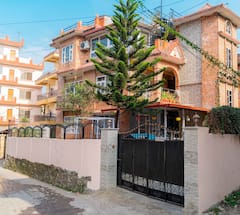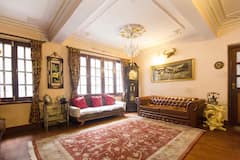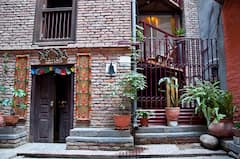If you have a picture in your head of Kathmandu as nomadic tribal lands and isolated mountainscape, you must be thinking of the Kathmandu of 50 years ago. These days, Kathmandu and Nepal, in general, is no longer the newly discovered Shangri-la. That title has now been taken by Bhutan. Kathmandu is now an urban-rural city in Nepal. While a certain amount of the mountain lifestyle remains, (it is still, after all, surrounded by major formations like Shivapuri, Phulchoki, and Nagarjuna), it now is the most populous and technologically advanced city in all of Nepal.
Misconceptions like this help people prepare for what might be a once-in-a-lifetime trip to Nepal. If you’re thinking of visiting this city of culture anytime soon, here are a couple of basics to help you prepare:
How to get to Kathmandu

While Kathmandu isn’t as inaccessible as it used to be, its international flight carriers are still limited. Tribhuvan International Airport in Kathmandu is the only international airport in Nepal. This being said, it can get quite chaotic when flights arrive. There are still a couple of hubs that you can use to fly into Nepal. Airline carriers flying into the city include Nepal Airlines, Air India, Jet Airways, Etihad Airways, Qatar Airways, AirAsia, and SilkAir. Popular connecting hubs for Nepal include Bangkok, Doha, Hong Kong, Kuala Lumpur, Muscat, Seoul, and Singapore.
By land, you can also get in from India and Tibet. From India, you can arrive from Varanasi, Patna, Gorakhpur, and Lucknow. From Tibet, you can get in from Kodari, which will take about six hours.
Tribhuvan International Airport
Address: Ring Rd, Kathmandu 44600, Nepal
Contact: +977 1 4113033
Website: Tribhuvan International Airport
What climate to prepare for

The climate in the mountains can be a little tricky to prepare for. Generally, because Kathmandu is dead center between high mountains, the heat has a tendency to be a bit insulated, here. However, this doesn’t mean you shouldn’t prepare for chilly weather. Evenings and early mornings can get quite cool. The secret to preparing for whatever climate comes your way is layering. Scarves should be mandatory, as well as one good, reliable jacket. There are yak wool scarves and jackets you can purchase locally if you want to help out the local economy. Other than the weather, you also have local customs to think about. Generally, Nepalese men and women dress quite conservatively. That means you should take care to not show too much skin on your legs and arms. Long bottoms, pants or trousers are a safe choice for the average temperature in Kathmandu. If you plan to trek and head to a higher elevation, you can purchase more adequate, (albeit knockoff), outerwear in the city.
Clothing in Nepal
Address: Nayabazar, Kathmandu Nepal
Contact: +977 1 4364786
Website: Clothing in Nepal
How to get around

Of course, you can get around Kathmandu on foot, as most travelers prefer. This is ideal if you have a lot of time in Kathmandu before going on to other parts of Nepal. However, if you’re pressed for time and would like to visit other areas outside of tourist-heavy Thamel, where rickshaws are available, you’ll want to use a metered taxi. To emphasize, you have to make sure that it’s a metered taxi unless you are going on a longer trip. Taxis are also hard to find around midnight. You might want to negotiate with a driver to wait for you or come back for you when you’re done. Other than taxis, there are buses that go on looped routes around the city. You’ll need very good navigational skills for this, though, since Nepal doesn’t really have a lot of road signs. Even when you have a map, they usually only name major roadways and not small alleyways. Needless to say, you can always ask. Nepalese locals are very helpful.
You might be interested in these Airbnbs!
What to eat and drink

Chiya is the closest thing to a national drink in Nepal. Quite similar to Indian Chai, with spices like cardamom, Chiya is available in almost all restaurants and bhattis, or small shops for locals. With food, the national obsession seems to be momos. Momos are dumplings steamed over a soup or broth. You’ll find momo shops everywhere in Kathmandu, and they have a lot of versions. There are vegetable and beef momos, open-faced and closed momos and steamed or fried momos. The best part is, momos are affordable. They can be as cheap as 2 USD, a meal. Other than momos, try the Dal Bhat - a rice and lentil soup with pickles and curd.
Read our article on the best food to try in Kathmandu.
Secret Food Tour in Kathmandu
Address: Nayabazar, Kathmandu Nepal
Contact: +977 9 818421646
Website:
Kathmandu Tour Guide
Dinesh Thapa Magar
Meet Dinesh, your go-to guide for an unforgettable Nepal experience. With years of expertise, he seamlessly blends city charm with mountain thrill. Let Dinesh unveil Nepal's secrets, from vibrant streets to towering peaks, creating memories that linger far beyond the journey.
Kathmandu Tour Guide
Kshitij
Kathmandu Tour Guide
Krishna Gautam
Namaskar (Hello)!Greetings from the land of discovery and adventure! I'm Krishna Gautam, a dedicated tour guide and travel planner for Nepal's breathtaking natural beauty and rich heritage of culture. I come with a Profound educational background and bring an original perspective to the journey. I received a master's degree in Rural Development and am currently pursuing an MPhil in Buddhist Studies and Yog Science at Tribhuvan University. In addition to my guiding experience, my university studies enable me to provide insightful commentary on Nepal's natural beauty and spiritual heart. With 29 years of expertise as a guide, I have been all throughout Nepal and have seen a variety of landscapes, from thrilling treks up to the basecamps of towering mountains to cultural journeys. I tailor every experience to fit your interests and schedule, whether it's taking in the colorful panorama of UNESCO World Heritage sites, going on challenging day treks, or taking all-inclusive round excursions to the most popular tourist attractions in Nepal, With so many attractions, Nepal has something to offer every kind of traveler. I promise that every second of your adventure will be full of excitement and discovery, from the busy streets of Kathmandu to the peaceful lakeside of Pokhara, from the greenery of Chitwan to the treasured birthplace of Lord Buddha in Lumbini.Some of the well-known locations I specialize in are cultural tours of Kathmandu's UNESCO World Heritage Site, as well as hidden gems that are just waiting to be discovered in Annapurna, Langtang, Manaslu, Upper Mustang, Dolpo, Ganesh Himal, Panchpokhari, Rolwaling, Solukhumbhu (the region surrounding Mount Everest), Makalu, and Kanchenjunga. My first priority are your comfort and happiness, and I take great pride in creating customized itineraries that meet your goals and interests. Whether you are looking for peaceful moments of reflection in the middle of nature, I can create a unique experience just for you.Allow me to serve as your guide as you set off on a wonderful adventure to discover the wonders and mysteries of Nepal's breathtaking landscape and deep cultural legacy. Let us together make some memories.I'm excited to plan your journey on this amazing journey just for you!Thank you!
What to watch out for

Generally, Nepal is in the middle of rebuilding, after the disastrous earthquake of 2015. It is a resilient city, but it also happens to be a city that needs economic help. This makes it prone to people who need instant cash like any other country in the world. You’ll have to be careful with your belongings because pickpockets are out and about. Tourists are especially lucrative victims.
In terms of food and water, always make sure to drink filtered water whether you’re in a restaurant or in your hotel. Even locals do not drink water from the tap anymore. For food, even street food is relatively safe. However, you are the best gauge when it comes to your stomach’s sensitivity. While Nepalese food isn’t as spicy as in India, there are a couple of food items that may be incompatible with your normal diet such as cottage cheese, the preparation of which includes fermentation, as well as a couple of pickled aachar condiments.
Emergency Numbers in Nepal
Contact: +997 4 226359 / +977 4 226403
Website: Emergency Numbers in Nepal
Historical beauty
It’s easy to get lost in the cultural and historical beauty of Nepal. Each back street and alleyway has an interesting backstory to tell, not to mention the temples that seem to be in every corner. A lot of sites in Nepal are UNESCO World Heritage Sites. This means that, while modernization is slowly creeping in, there is still so much of its identity that remains true to the Kathmandu of old. Kathmandu is a city on the cusp of full modernization, so it is best to enjoy it while it is still holding on to the skirts of its yesteryears. Pretty soon, it might just be like every other city in the world.
History
Get Trip101 in your inbox
Unsubscribe in one click. See our Privacy Policy for more information on how we use your data























Create an account to